

Collections as Data - Part to Whole. Collections as Data: Part to Whole aims to foster the development of broadly viable models that support implementation and use of collections as data.

This effort is made possible by The Andrew W. Tools - Digital Humanities - LibGuides at MIT Libraries. The Programming Historian. Sublime Text: The text editor you'll fall in love with. Fördjupning: Digitala textkritiska utgåvor – Historia i en digital värld. Jenny Bergenmar Argumenten för att ge ut textkritiska utgåvor bygger ofta på författarskapets litterära och kulturella betydelse. ”Topelius litterära verk är ett monument i ord över Finlands 1800-talshistoria och utgivningen är därför en nationell uppgift av nordisk bärvidd”, skriver redaktionen för Zacharias Topelius Skrifter.

Det är författare som tillmäts denna betydelse som blir föremål för textkritiska utgåvor. Några av de mest påkostade nordiska utgivningsprojekten är följaktligen Topelius, Henrik Ibsens skrifter och Nationalupplagan av Strindbergs samlade verk. Dessa tre projekt, liksom exempelvis The Rossetti Archive illustrerar väl den kanoniserande och kulturkonserverande funktion en textkritisk utgåva ofta fyller. A Review of Selected Digital Humanities Centers and Initiatives (March 2016) - Harvard University Arts & Humanities Research Computing. A Review of Selected Digital Humanities Centers and Initiatives (March 2016)by: Gosia Stergios Many believe that humanities computing, later called “digital humanities,” (DH) originated in 1949.
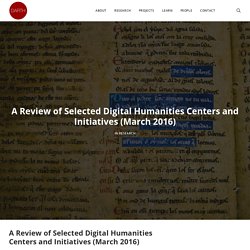
It was the year when an Italian Jesuit, Father Roberto Busa, came to IBM, the only organization in the world that possessed the technology (punch card machines) and the expertise he needed to create a concordance of all the words in the works of St Thomas Aquinas—the Index Thomisticus. Almost seven decades later, The Alliance of Digital Humanities Organizations (ADHO) lists over 175 DH centers, initiatives, labs, collectives and networks, ranging from small labs and virtual support centers to large physical facilities packed with hardware, and even full-fledged, degree-granting academic departments.
Chapter 4: Image processing in the digital humanities. Melissa Terras Chapter Overview Chapter 4 discusses the ways in which images, once digitized, can be manipulated, studied and processed.
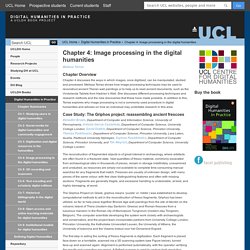
Melissa Terras shows how image-processing techniques may be used to reconstruct ancient Theran wall paintings or to help us to read ancient documents, such as the Vindolanda Tablets from Hadrian’s Wall. She discusses different processing techniques and research methods and the new discoveries that these have made possible. In addition to this, Terras explores why image processing is not a commonly used procedure in digital humanities and advises on how an individual may undertake research in this area. Case Study: The Griphos project: reassembling ancient frescoes The reconstruction of fragmented objects is of great interest in archaeology, where artefacts are often found in a fractured state. Academic History Writing and the Headache of Big Data. By way of a preface The post that follows is formed from the text of a presentation I am due to deliver at King's College London on 9 February, but which reflects what I was worrying about in early December 2011 - several months after I wrote the synopsis that was used to advertise the talk, a month before I attended the AHA conference in Chicago with its extensive programme on digital histories, and six weeks before I got around to reading Stephen Ramsay's, Reading Machines: Toward an Algorithmic Criticism.
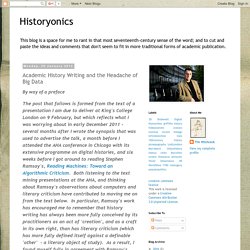
Both listening to the text mining presentations at the AHA, and thinking about Ramsay's observations about computers and literary criticism have contributed to moving me on from the text below. Digital Humanities. Tamsys.sourceforge. DLF Community Calendar. Our community calendar covers events relevant to Digital Libraries and Archives, Digital Humanities, and Digital Museums, as well as a growing number of Open Science and Digital Publishing events worldwide.
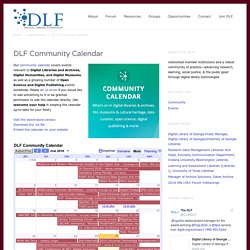
Please let us know if you would like to add something to it or be granted permission to edit the calendar directly. Local Projects. Exploratory Programming for the Arts and Humanities. “Exploratory Programming for the Arts and Humanities provides artists and humanists with privileged access to a highly sophisticated understanding of the concepts and practices that make computer code into such a powerful means of human expression.
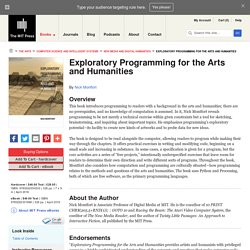
Nick Montfort is a reassuring guide through this forbidden realm, a master magician who is eager to share his tricks, a fellow humanist/artist who understands computation with an unusual intimacy and historical perspective, and who is bent on demystifying the arcane, celebrating the playful, and generally making the wonders of computation available to a wider range of cultural and creative explorers.” —Janet H. Digital Humanities Centre. Digital Humanities in Swedish research (DHN 2016)
DH Toolbox. Introduction The following is a list of tools that was created during the HASTAC Scholars Unconference at Michigan State University on May 27, 2015.
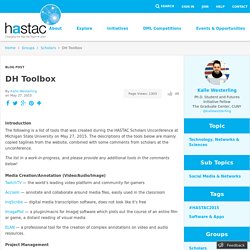
The descriptions of the tools below are mainly copied taglines from the website, combined with some comments from scholars at the unconference. The list in a work-in-progress, and please provide any additional tools in the comments below! Media Creation/Annotation (Video/Audio/Image) Introduction to Digital Humanities. Scroll to the bottom of the page for a PDF download of these instructions.
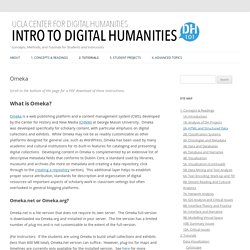
Omeka is a web publishing platform and a content management system (CMS), developed by the Center for History and New Media (CHNM) at George Mason University. Omeka was developed specifically for scholarly content, with particular emphasis on digital collections and exhibits. While Omeka may not be as readily customizable as other platforms designed for general use, such as WordPress, Omeka has been used by many academic and cultural institutions for its built-in features for cataloging and presenting digital collections.
Developing content in Omeka is complemented by an extensive list of descriptive metadata fields that conforms to Dublin Core, a standard used by libraries, museums and archives (for more on metadata and creating a data repository, click through to the creating a repository section). Omeka.net is a lite-version that does not require its own server. Building a Repository in Omeka. Biodiversity Heritage Library. International Image Interoperability Framework. Conflict Resolution and Peace. Teachers can use these quotes from famous individuals to facilitate student reflection on the importance of conflict resolution.
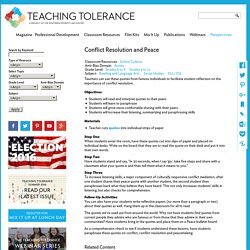
Objectives Students will read and interpret quotes to their peers Students will learn to paraphrase Students will grow more comfortable sharing with their peers Students will increase their listening, summarizing and paraphrasing skills Materials Teacher cuts quotes into individual strips of paper Step One When students enter the room, have these quotes cut into slips of paper and placed on individual desks. Step Two Have students stand and say, "In 30 seconds, when I say ‘go,' take five steps and share with a classmate what your quote is and then tell them what it means to you. " Step Three To increase listening skills, a major component of culturally responsive conflict mediation, after one student shares their peace quote with another student, the second student then paraphrases back what they believe they have heard.
Prof.dr. A.H. (Adriaan) van der Weel - Members - Humanities - Geesteswetenschappen - Universiteit Leiden. DHQ: Digital Humanities Quarterly: Contact. Manuscript transcription projects - Folgerpedia. Fully reported projects Annotated Books Online (ABO) Project Scope: This project based at the University of Utrecht seeks to become a central, international, digital transcription and translation library.
There is a particular focus on famous early readers, including Gabriel Harvey, Martin Luther, and Philipp Melanchthon. Management Approach: The project relies on academic-style crowd-sourcing, requiring high-level translation and transcription skills. Sheets - create and edit spreadsheets online, for free. Special Topics and Tools. DocsTeach. Education sessions and resources - The National Archives.
Education sessions and resources - The National Archives. Secondary schools and Further Education. We offer a range of free workshops for Secondary schools and Further Education groups which use our gallery spaces to develop creative thinking, visual and verbal literacy and research skills. Click on the links below to find out more. Research Matters Ideal for a first visit, this cross-curricular, creative workshop introduces students to the concept of research. Digital Pathways Digital Pathways develops digital research skills through an enquiry-led session. Write Here! Be inspired by some of the great writers and original drafts housed at the British Library in this creative writing workshop. Ways of Reading Using the original manuscripts on display in the British Library’s treasures gallery, students will explore the processes of writing, re-drafting and editing.
Exploring English Exploring English workshops offer students the opportunity to develop skills in language analysis and interpretation. Sounds Familiar? Sacred Texts. The UVic Image Markup Tool Project. Creating “Getty Scholars’ Workspace”: Lessons from the Digital Humanities Trenches. Francesca Albrezzi of the Getty Research Institute provides a behind-the-scenes look of challenges faced and lessons learned in building “Digital Mellini,” the first of three projects in Getty Scholars’ Workspace, a scholarly collaboration environment that’s been described as “Wordpress for scholars.” For a previous progress update on Digital Mellini, see this post. “But is it innovative?”
That’s a question we’ve asked ourselves time after time about a digital humanities project we’ve been working on for almost two years. Called Digital Mellini, it’s the first in a series of projects that aim to create digital critical facsimile editions of art historical texts. Digital Humanities and the Library. A Bibliography I originally prepared this bibliography for the Association of Research Libraries’ Digital Humanities SPEC Kit, an abstract of which is available here. I try to update this list frequently. Additions welcome. I hope that this list provides useful background reading, but for the latest-and-greatest writing on librarianship and digital humanities, please see dh+lib, a fantastic blog run by the DH Discussion Group of the Association of College and Research Libraries.
You can also follow @DHandLib on Twitter. To read portions of this list in convenient ebook form, check out this digital humanities and libraries ebook, the work of a group of librarians at THATCamp ACRL in April 2013. Last updated: April 2013. What is the point of an online interactive OCR text editor? The Digitization Project of Kindred Languages is not only about the publishing Fenno-Ugric material online,but it also aims to support the linguistic research by developing purposeful tools for its help. In this blog entry, Wouter Van Hemel of the National Library of Finland sheds the light over the OCR editor, which enables the editing of machine-encoded text for the benefit of linguistic research by crowdsourcing.
The PAS (long-time preservation) team at the Kansalliskirjasto concentrates its effort on the digital preservation of valuable historical and cultural materials so that while the physical form of works might deteriorate and even disappear over time, the information therein can live on forever in the digital realm, accessible to all. With the OCRUI editor, the Kansalliskirjasto wants to extend this approach to the correction process of OCR material. The ALTO format The OCRUI application is in essence an editor for these ALTO XML files. Architecture. About Us. What is VUE? At its core, the Visual Understanding Environment (VUE) is a concept and content mapping application, developed to support teaching, learning and research and for anyone who needs to organize, contextualize, and access digital information. About DataBank. DataBank is a scalable data repository designed for institutional deployment.
How to reduce the size of a pdf document in OS X - Macintosh How To. Mar 09 Depending on what program you used to create a PDF, the file size of your PDF file can be quite large. If you combine two or three PDF files together using preview, you can also end up with a bloated PDF file. The best way to reduce PDF file size is with Acrobat professional, which can do all sorts of magic on PDF files.
Digi-Tools.